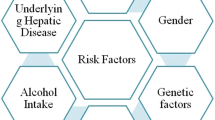Summary
The liver plays an important rôle in protecting the organism from potentially toxic chemical insults through its capacity to convert lipophiles into more water-soluble metabolites which can be efficiently eliminated from the body via the urine. This protective ability of the liver stems from the expression of a wide variety of xenobiotic biotransforming enzymes whose common underlying feature is their ability to catalyse the oxidation, reduction and hydrolysis (Phase I) and/or conjugation (Phase II) of functional groups on drug and chemical molecules. The broad substrate specificity, isoenzyme multiplicity and inducibility of many of these enzyme systems make them particularly well adapted to handling the vast array of different chemical structures in the environment to which we are exposed daily. However, some chemicals may also be converted to more toxic metabolites by certain of these enzymes, implying that variations in the latter may be important predisposing factors for toxicity. Pharmacogenetic defects of xenobiotic biotransformation enzymes, a subclass of inborn errors of metabolism which are manifested only upon drug challenge, introduce marked variation into human populations for the pharmacokinetics and pharmacodynamics of therapeutic and toxic agents, and thus may have important clinical consequences for drug efficacy and toxicity.
Similar content being viewed by others
References
Arnaud, M. J. Products of metabolism of caffeine. In: Dews, P. B. (ed.),Caffeine, Springer-Verlag, Berlin, 1984, pp. 3–38
Blum, M., Grant, D. M., Demierre, A. and Meyer, U. A. N-acetylation pharmacogenetics: a gene deletion causes absence of arylamine N-acetyltransferase in liver of slow acetylator rabbits.Proc. Natl. Acad. Sci. USA 86 (1989) 9554–9557
Blum, M., Grant, D. M., McBride, W., Heim, M. and Meyer, U. A. Human arylamine N-acetyltransferase genes: isolation, chromosomal localization, and functional expression.DNA Cell Biol. 9 (1990) 193–203
Blum, M., Demierre, A., Grant, D. M., Heim, M. and Meyer, U. A. Molecular mechanism of slow acetylation of drugs and carcinogens in man.Proc. Natl. Acad. Sci. USA (1991) (in press)
Evans, D. A. P. N-acetyltransferase.Pharmacol. Ther. 42 (1989) 157–234
Gonzalez, F. J. The molecular biology of cytochrome P450s.Pharmacol. Rev. 40 (1989) 243–288
Grant, D. M., Tang, B. K. and Kalow, W. A simple test for acetylator phenotype using caffine.Br. J. Clin. Pharmacol. 17 (1984) 459–464
Grant, D. M., Lottspeich, F. and Meyer, U. A. Evidence for two closely related isozymes of arylamine N-acetyltransferase in human liver.FEBS Lett. 244 (1989) 203–207
Grant, D. M., Moerike, K., Eichelbaum, M. and Meyer, U. A. Acetylation pharmacogenetics: the slow acetylator phenotype is caused by decreased or absent arylamine N-acetyltransferase in human liver.J. Clin. Invest. 85 (1990) 968–972
Grant, D. M., Blum, M., Beer, M. and Meyer, U. A. Monomorphic and polymorphic human arylamine N-acetyltransferases: a comparison of liver isoenzymes and expressed products of two cloned genes.Mol. Pharmacol. 39 (1991) 184–191
Jakoby, W. B. Detoxication: conjugation and hydrolysis. In Arias, I. M., Jakoby, W. B., Popper, H., Schacter, D. and Shafritz, D. A. (eds.),The Liver: Biology and Pathobiology, Raven Press, New York, 1988, pp. 375–388
Meyer, U. A. Molecular genetics and the future of pharmacogenetics.Pharmacol. Ther. 46 (1990) 349–355
Meyer, U. A., Zanger, U. M., Grant, D. M. and Blum, M. Genetic polymorphisms of drug metabolism.Adv. Drug Res. 19 (1990) 197–241
Miller, E. C. Some current perspectives on chemical carcinogenesis in humans and experimental animals.Cancer Res. 38 (1978) 1479–1496
Nebert, D. W., Nelson, D. R. and Feyereisen, R. Evolution of the cytochrome P450 genes.Xenobiotica 19 (1989) 1149–1160
Ohsako, S. and Deguchi, T. Cloning and expression of cDNAs for polymorphic and monomorphic arylamine N-acetyltransferases from human liver.J. Biol. Chem. 265 (1990) 4630–4634
Okey, A. B. Enzyme induction in the cytochrome P450 system.Pharmacol. Ther. 45 (1990) 241–298
Spielberg, S. P.In vitro assessment of pharmacogenetic susceptibility to toxic drug metabolites in humans.Fed. Proc. 43 (1984) 2308–2313
Ziegler, D. M. Detoxication: oxidation and reduction. In Arias, I. M., Jakoby, W. B., Popper, H., Schacter, D. and Shafritz, D. A. (eds.),The Liver: Biology and Pathobiology, Raven Press, New York, 1988, pp. 363–374
Author information
Authors and Affiliations
Rights and permissions
About this article
Cite this article
Grant, D.M. Detoxification pathways in the liver. J Inherit Metab Dis 14, 421–430 (1991). https://doi.org/10.1007/BF01797915
Issue Date:
DOI: https://doi.org/10.1007/BF01797915




